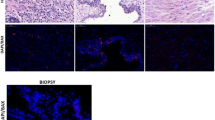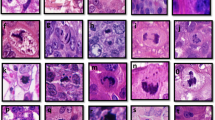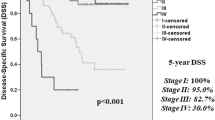Abstract
Following breast-conserving surgery for ductal carcinoma in situ (DCIS), the presence of comedo necrosis reportedly predicts for higher rates of post-operative recurrence. To examine the role of programmed cell death (apoptosis) in the aetiology of the cell death described as comedo necrosis, we studied 58 DCIS samples, using light microscopy, for morphological evidence of apoptotic cell death. The percentage of apoptotic cells (apoptotic index, AI) was compared between DCIS with and without evidence of 'comedo necrosis' and related to the immunohistochemical expression of the anti-apoptosis gene bcl-2, mitotic index (MI), the cellular proliferation antigen Ki67, nuclear grade and oestrogen receptor (ER) status. AI was significantly higher in DCIS samples displaying high-grade comedo necrosis than in low-grade non-comedo samples: median AI = 1.60% (range 0.84-2.89%) and 0.45% (0.1-1.31%) respectively (P < 0.001). Increasing nuclear grade correlated positively with AI (P < 0.001) and negatively with bcl-2 expression (P = 0.003). Bcl-2 correlated negatively with AI (P = 0.019) and strongly with ER immunoreactivity (P < 0.001). Cellular proliferation markers (MI and Ki67 immunostaining) correlated strongly with AI and were higher in comedo lesions and tumours of high nuclear grade (P < 0.001 in all cases). Thus, apoptosis contributes significantly to the cell death described in ER-negative, high-grade DCIS in which a high proliferative rate is associated with a high apoptotic rate. It is likely that dysregulation of proliferation/apoptosis control mechanisms accounts for the more malignant features typical of ER negative comedo DCIS.
This is a preview of subscription content, access via your institution
Access options
Subscribe to this journal
Receive 24 print issues and online access
$259.00 per year
only $10.79 per issue
Buy this article
- Purchase on Springer Link
- Instant access to full article PDF
Prices may be subject to local taxes which are calculated during checkout
Similar content being viewed by others
Author information
Authors and Affiliations
Rights and permissions
About this article
Cite this article
Gandhi, A., Holland, P., Knox, W. et al. Evidence of significant apoptosis in poorly differentiated ductal carcinoma in situ of the breast. Br J Cancer 78, 788–794 (1998). https://doi.org/10.1038/bjc.1998.580
Issue Date:
DOI: https://doi.org/10.1038/bjc.1998.580
This article is cited by
-
Dedifferentiation-mediated stem cell niche maintenance in early-stage ductal carcinoma in situ progression: insights from a multiscale modeling study
Cell Death & Disease (2022)
-
Apoptosis and production of TNF-α by tumor-associated inflammatory cells in histological grade III breast cancer
Cancer Immunology, Immunotherapy (2005)
-
COX-2 expression is associated with an aggressive phenotype in ductal carcinoma in situ
British Journal of Cancer (2004)
-
The transcription factor DEC1 (stra13, SHARP2) is associated with the hypoxic response and high tumour grade in human breast cancers
British Journal of Cancer (2004)
-
In vivo cell kinetics in breast carcinogenesis
Breast Cancer Research (2001)



